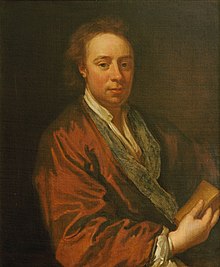Adrian Beverland
Adrian Beverland | |
|---|---|
 Adrian Beverland in 1689 | |
| Born | 1650 |
| Died | 1716 (aged 66) |
| Occupation | Dutch philosopher |
Adriaan Beverland, known in English and French as Adrian Beverland (20 September 1650 Middelburg, Zeeland — 14 December 1716 London) was a Dutch philosopher and jurist who settled in England.
Life

Adrian Beverland studied at Leiden University, where he produced a treatise on Original sin, for which he was expelled from the university, imprisoned and fined, but released on promising never to write on the subject again. He then moved to Utrecht, where his behaviour led to the magistrates privately warning him to leave the city; in response he wrote a satire called Vox clamantis in deserto, which he distributed in manuscript form.[1]
In 1679 he moved to England as secretary to Isaac Vossius. In 1684, he was appointed a gentleman of the Horse in the household of John Vaughan, 3rd Earl of Carbery.
In 1698,[1] he published De fornicatione cavenda: admonitio sive adhortatio ad pudicitiam et castitatem, with a new edition in 1710.[2] In this he claimed to have repented of his former dissolute lifestyle, asking in the preface, anyone who had a manuscript of his previous works "to return it to me, that I may burn it myself".[1]
He fell into a state of poverty following the death of Vossius.[1] By 1692, he was living in London and died there in 1716 insane.
His annotated copy of Basilii Fabri, sorani, Thesaurus eruditionis scholasticae (Leipzig, 1696) is in the library of St Johns College Cambridge.[3]
Portraits
In a portrait attributed to Ary de Vois, now in the Rijksmuseum, Beverland is shown seated at a table, with a prostitute.[4] There is another painting of him in the Ashmolean Museum, Oxford,[5] once thought to be by Godfrey Kneller.[1] An engraving of 1686 by Isaac Beckett, after a design by Simon du Bois shows Beverland, (in a parody of a respectable 1670 frontispiece by Abraham Blotelingh of Lorenzo Pignoria), amongst Egyptian antiquities, sketching a female nude.[6]
References
- ^ a b c d e Chalmers, Aleexander (1812). The General Biographical Dictionary. Vol. 5. London. p. 201. Retrieved 15 December 2011.
{{cite book}}: Cite has empty unknown parameter:|coauthors=(help), Biography (1812), V, 201. - ^ Beverland, A. (1710). De fornicatione cavenda: admonitio sive adhortatio ad pudicitiam et castitatem. Retrieved 26 August 2015.
- ^ "St John's College H.21-23 (James 286-8)". St John's College Cambridge. Retrieved 15 December 2011.
- ^ "Adriaan van Breverland". Rijksmuseum. Archived from the original on 9 September 2012. Retrieved 15 December 2011.
{{cite web}}: Unknown parameter|dead-url=ignored (|url-status=suggested) (help) - ^ "Dutch Artist (c.1690): Adriaan Beverland". Ashmolean Museum. Retrieved 15 December 2011.
- ^ Edward Chaney, "Roma Britannica and the Cultural Memory of Egypt: Lord Arundel and the Obelisk of Domitian", in Roma Britannica: Art Patronage and Cultural Exchange in Eighteenth-Century Rome, eds. D. Marshall, K. Wolfe and S. Russell, British School at Rome, 2011, pp. 147–70
Sources
- Rudolf De Smet, Hadrianus Beverlandus (1650-1716). Non unus e multis peccator. Studie over het leven en werk van Hadriaan Beverland. Brussel: Paleis der Academiën 1988 (187 pp.).
